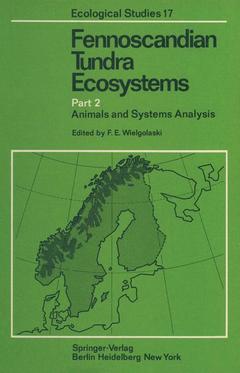Fennoscandian Tundra Ecosystems, Softcover reprint of the original 1st ed. 1975 Part 2 Animals and Systems Analysis Ecological Studies Series, Vol. 17
Langue : Anglais
Coordonnateur : Wielgolaski Frans Emil

Animals are important components of any ecosystem and it is impossible to describe structure and funCtioning of the Fennoscandian tundra ecosystems without including this part of the system. However, the strong diversity between functionally highly different fauna groups makes it impossible to study all groups in great detail with the funds and expertise available in Fennoscandia. Relatively few productivity studies were carried out on animals in Fenno scandian tundra regions before the IBP projects started in 1969-1970. Within IBP, more fauna groups have been investigated in the Norwegian tundra project than in the other countries, due to better financial support. Even in Norway, however, only a limited number of invertebrate and vertebrate taxons is studied. General lack of information on the same animals in various parts of the Fennoscandian tundra makes it more difficult to present structural and functional comparisons of fauna for the whole region than in plants and microorganisms (see Part 1 of Fennoscandian Tundra Ecosystems). Brief surveys on faunal problems within the area are given in the introduction to the animal section, and general aspects are also discussed in the four first papers of the volume.
of Part 2.- 1. Animals.- Area Size and Niche Breadth at Higher Latitudes.- 1.1. Faunal Structure of Research Areas.- Faunal Structure of Investigated Areas at Kevo, Finland.- Faunal Structure of Hardangervidda, Norway.- Faunal Structure of the IBP Tundra Site and Its Surroundings, Abisko, Sweden.- 1.2. Organization and Dynamics of Populations.- Dynamics of Enchytraeidae Populations on Hardangervidda.- Dynamics of Oribatei Populations on Hardangervidda.- Spider Populations in a Subalpine Birch Forest.- Organization and Dynamics of Collembola Populations on Hardangervidda.- Dynamics of Thysanoptera Populations on Hardangervidda.- Dynamics of Aphididae Populations on Hardangervidda.- Occurrence and Role of Different Invertebrate Groups in Alpine Salix herbacea Snowbeds at Hardangervidda.- Structure of Small Passerine Communities in Subalpine Birch Forests in Fennoscandia.- Density Variations of Bird Populations in High Mountain Habitats, Hardangervidda.- 1.3. Bioenergetics.- Influence of Various Temperature Approximations on Estimates of Field Respiration in a Mountain Community.- Respiration Rates, Winter and Summer Activity in Collembola on Hardangervidda.- Respiratory Rates and Respiratory Energy Loss in Terrestrial Invertebrates from Hardangervidda.- Energetics in a Population of Pardosa palustris (L.) (Araneae, Lycosidae) on Hardangervidda.- Life Cycle and Energy Budget of Tipula excisa (Schum.) (Diptera, Tipulidae).- Standing Crop and Calorific Content in Invertebrates from Hardangervidda.- Food Habits and Body Composition of Adult and Juvenile Meadow Pipit [Anthus pratensis (L.)].- Energy Budget of a Population of the Root Vole [Microtus oeconomus (Pall.)] in a High Mountain Habitat, Hardangervidda.- 1.4. Herbivory Aspects.- On the Ecocatastrophe of Birch Forests Caused by Oporinia autumnata (Bkh.) and the Problem of Reforestation.- Birch Herbivores and Herbivory at Kevo.- Importance Criteria in Birch Defoliators.- Wild Reindeer Food Habits and Range Use at Hardangervidda.- Reindeer Activity on Hardangervidda.- Grazing by Sheep.- 2. Conservation and Recreation in Tundra Ecosystems.- Stability of Tundra Ecosystems in Fennoscandia.- Remote Sensing of Vegetation in Conservation of Tundra Landscapes.- 3. Models for Integration and Prediction.- Principles in the Use of Wide-Scale Models on Tundra Data.- A Mathematical Simulation Model for Terrestrial Tundra Ecosystems.- Systems Analysis on Invertebrates.- A Simulation Model of a Small Rodent Population.- Energy Model for Individual Small Rodents and Its Significance in General Population Theory.- Functioning of Fennoscandian Tundra Ecosystems.
Date de parution : 03-1976
Date de parution : 12-2011
Ouvrage de 338 p.
17x24.4 cm
Thème de Fennoscandian Tundra Ecosystems :
Mots-clés :
Skandinavien /Biologie; Tiere; Tundra; animals; biology; ecology; ecosystem; ecosystems; fauna; invertebrates; lake; Ökologie
© 2024 LAVOISIER S.A.S.



